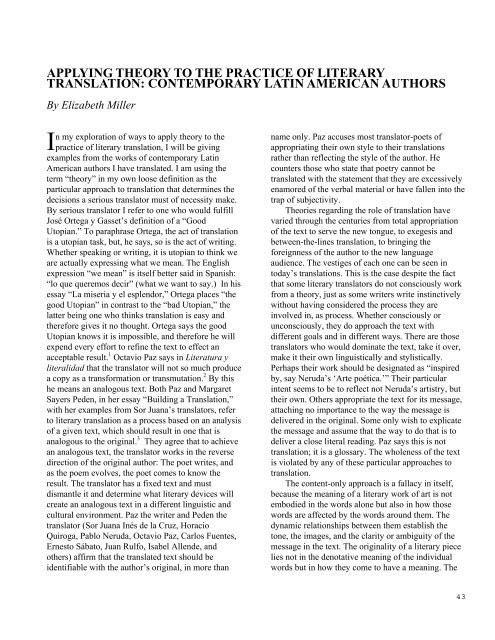their - The University of Texas at Dallas
their - The University of Texas at Dallas
their - The University of Texas at Dallas
You also want an ePaper? Increase the reach of your titles
YUMPU automatically turns print PDFs into web optimized ePapers that Google loves.
APPLYING THEORY TO THE PRACTICE OF LITERARY<br />
TRANSLATION: CONTEMPORARY LATIN AMERICAN AUTHORS<br />
By Elizabeth Miller<br />
I<br />
n my explor<strong>at</strong>ion <strong>of</strong> ways to apply theory to the<br />
practice <strong>of</strong> literary transl<strong>at</strong>ion, I will be giving<br />
examples from the works <strong>of</strong> contemporary L<strong>at</strong>in<br />
American authors I have transl<strong>at</strong>ed. I am using the<br />
term “theory” in my own loose definition as the<br />
particular approach to transl<strong>at</strong>ion th<strong>at</strong> determines the<br />
decisions a serious transl<strong>at</strong>or must <strong>of</strong> necessity make.<br />
By serious transl<strong>at</strong>or I refer to one who would fulfill<br />
José Ortega y Gasset’s definition <strong>of</strong> a “Good<br />
Utopian.” To paraphrase Ortega, the act <strong>of</strong> transl<strong>at</strong>ion<br />
is a utopian task, but, he says, so is the act <strong>of</strong> writing.<br />
Whether speaking or writing, it is utopian to think we<br />
are actually expressing wh<strong>at</strong> we mean. <strong>The</strong> English<br />
expression “we mean” is itself better said in Spanish:<br />
“lo que queremos decir” (wh<strong>at</strong> we want to say.) In his<br />
essay “La miseria y el esplendor,” Ortega places “the<br />
good Utopian” in contrast to the “bad Utopian,” the<br />
l<strong>at</strong>ter being one who thinks transl<strong>at</strong>ion is easy and<br />
therefore gives it no thought. Ortega says the good<br />
Utopian knows it is impossible, and therefore he will<br />
expend every effort to refine the text to effect an<br />
acceptable result. 1 Octavio Paz says in Liter<strong>at</strong>ura y<br />
literalidad th<strong>at</strong> the transl<strong>at</strong>or will not so much produce<br />
a copy as a transform<strong>at</strong>ion or transmut<strong>at</strong>ion. 2 By this<br />
he means an analogous text. Both Paz and Margaret<br />
Sayers Peden, in her essay “Building a Transl<strong>at</strong>ion,”<br />
with her examples from Sor Juana’s transl<strong>at</strong>ors, refer<br />
to literary transl<strong>at</strong>ion as a process based on an analysis<br />
<strong>of</strong> a given text, which should result in one th<strong>at</strong> is<br />
analogous to the original. 3 <strong>The</strong>y agree th<strong>at</strong> to achieve<br />
an analogous text, the transl<strong>at</strong>or works in the reverse<br />
direction <strong>of</strong> the original author: <strong>The</strong> poet writes, and<br />
as the poem evolves, the poet comes to know the<br />
result. <strong>The</strong> transl<strong>at</strong>or has a fixed text and must<br />
dismantle it and determine wh<strong>at</strong> literary devices will<br />
cre<strong>at</strong>e an analogous text in a different linguistic and<br />
cultural environment. Paz the writer and Peden the<br />
transl<strong>at</strong>or (Sor Juana Inés de la Cruz, Horacio<br />
Quiroga, Pablo Neruda, Octavio Paz, Carlos Fuentes,<br />
Ernesto Sáb<strong>at</strong>o, Juan Rulfo, Isabel Allende, and<br />
others) affirm th<strong>at</strong> the transl<strong>at</strong>ed text should be<br />
identifiable with the author’s original, in more than<br />
name only. Paz accuses most transl<strong>at</strong>or-poets <strong>of</strong><br />
appropri<strong>at</strong>ing <strong>their</strong> own style to <strong>their</strong> transl<strong>at</strong>ions<br />
r<strong>at</strong>her than reflecting the style <strong>of</strong> the author. He<br />
counters those who st<strong>at</strong>e th<strong>at</strong> poetry cannot be<br />
transl<strong>at</strong>ed with the st<strong>at</strong>ement th<strong>at</strong> they are excessively<br />
enamored <strong>of</strong> the verbal m<strong>at</strong>erial or have fallen into the<br />
trap <strong>of</strong> subjectivity.<br />
<strong>The</strong>ories regarding the role <strong>of</strong> transl<strong>at</strong>ion have<br />
varied through the centuries from total appropri<strong>at</strong>ion<br />
<strong>of</strong> the text to serve the new tongue, to exegesis and<br />
between-the-lines transl<strong>at</strong>ion, to bringing the<br />
foreignness <strong>of</strong> the author to the new language<br />
audience. <strong>The</strong> vestiges <strong>of</strong> each one can be seen in<br />
today’s transl<strong>at</strong>ions. This is the case despite the fact<br />
th<strong>at</strong> some literary transl<strong>at</strong>ors do not consciously work<br />
from a theory, just as some writers write instinctively<br />
without having considered the process they are<br />
involved in, as process. Whether consciously or<br />
unconsciously, they do approach the text with<br />
different goals and in different ways. <strong>The</strong>re are those<br />
transl<strong>at</strong>ors who would domin<strong>at</strong>e the text, take it over,<br />
make it <strong>their</strong> own linguistically and stylistically.<br />
Perhaps <strong>their</strong> work should be design<strong>at</strong>ed as “inspired<br />
by, say Neruda’s ‘Arte poética.’” <strong>The</strong>ir particular<br />
intent seems to be to reflect not Neruda’s artistry, but<br />
<strong>their</strong> own. Others appropri<strong>at</strong>e the text for its message,<br />
<strong>at</strong>taching no importance to the way the message is<br />
delivered in the original. Some only wish to explic<strong>at</strong>e<br />
the message and assume th<strong>at</strong> the way to do th<strong>at</strong> is to<br />
deliver a close literal reading. Paz says this is not<br />
transl<strong>at</strong>ion; it is a glossary. <strong>The</strong> wholeness <strong>of</strong> the text<br />
is viol<strong>at</strong>ed by any <strong>of</strong> these particular approaches to<br />
transl<strong>at</strong>ion.<br />
<strong>The</strong> content-only approach is a fallacy in itself,<br />
because the meaning <strong>of</strong> a literary work <strong>of</strong> art is not<br />
embodied in the words alone but also in how those<br />
words are affected by the words around them. <strong>The</strong><br />
dynamic rel<strong>at</strong>ionships between them establish the<br />
tone, the images, and the clarity or ambiguity <strong>of</strong> the<br />
message in the text. <strong>The</strong> originality <strong>of</strong> a literary piece<br />
lies not in the denot<strong>at</strong>ive meaning <strong>of</strong> the individual<br />
words but in how they come to have a meaning. <strong>The</strong><br />
43

















